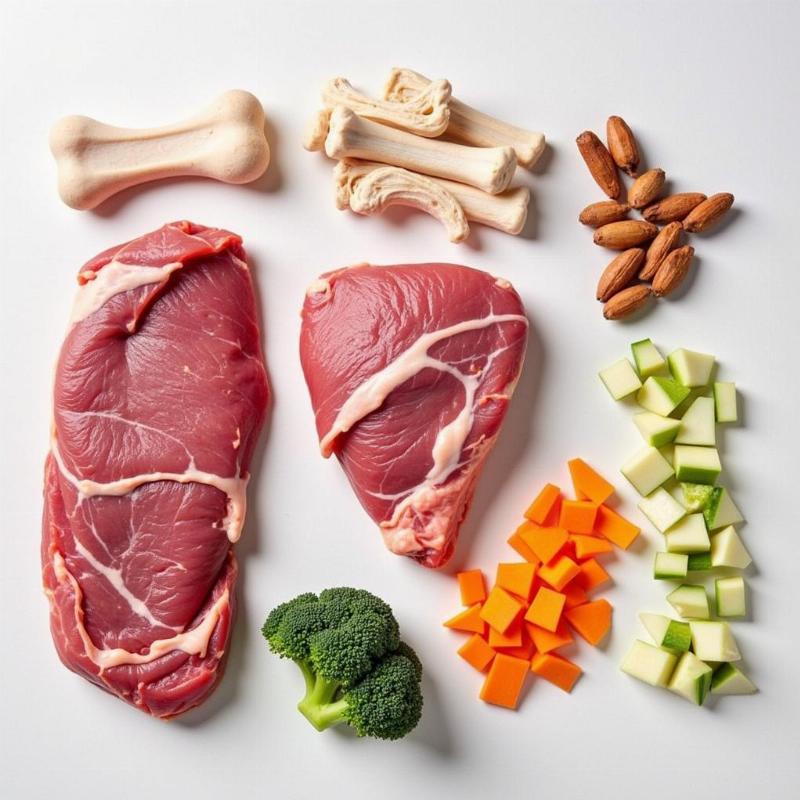A raw diet for older dogs is a topic that sparks both interest and concern among pet owners. Is it safe? Is it beneficial? As our canine companions enter their golden years, their nutritional needs change. This comprehensive guide will delve into the world of raw feeding for senior dogs, addressing common questions and providing practical advice for those considering this dietary approach in the United States.
Understanding the Nutritional Needs of Senior Dogs
As dogs age, their metabolism slows down, and they may become less active. This means they require fewer calories to maintain a healthy weight. However, their need for specific nutrients, like protein and certain vitamins and minerals, can actually increase. A raw diet, if formulated correctly, can address these changing needs by providing highly digestible protein and essential nutrients in their most natural form. Just like humans, senior dogs can benefit from a diet rich in antioxidants to combat oxidative stress and support overall health.
Benefits and Risks of a Raw Diet for Older Dogs
A raw diet can offer several potential benefits for senior dogs, including improved digestion, healthier skin and coat, increased energy levels, and stronger immune function. However, it’s crucial to be aware of the risks as well. Raw meat can contain harmful bacteria like Salmonella and E. coli, which can pose a greater threat to senior dogs with potentially weakened immune systems. Furthermore, improperly balanced raw diets can lead to nutritional deficiencies or excesses.
Creating a Balanced Raw Diet for Your Senior Dog
If you’re considering a raw diet for your older dog, consulting with a board-certified veterinary nutritionist is essential. They can help you create a balanced meal plan that meets your dog’s specific needs, taking into account any underlying health conditions. A balanced raw diet should include muscle meat, organ meat, bones, and vegetables in appropriate proportions. Supplementation may also be necessary to ensure adequate intake of certain vitamins and minerals.
Key Considerations for Raw Feeding Senior Dogs
- Dental Health: Older dogs may have dental issues that make chewing raw bones difficult. Consider offering ground bone or softer bone alternatives. best dog food for dogs with no teeth provides helpful information on alternative food options for dogs with dental problems.
- Digestive Health: Senior dogs can be more prone to digestive upset. Start with small portions of raw food and gradually increase the amount as your dog adjusts. zesty paws probiotics for dogs offers information on probiotics that may support digestive health.
- Food Safety: Practice meticulous hygiene when handling raw meat to minimize the risk of bacterial contamination. Wash your hands thoroughly, sanitize surfaces, and use separate cutting boards and utensils for raw food preparation. raw chicken wings for dogs discusses safe handling practices for raw chicken.
 Ingredients for a raw dog food diet
Ingredients for a raw dog food diet
Transitioning Your Older Dog to a Raw Diet
Transitioning to a raw diet should be done gradually. Start by mixing a small amount of raw food with your dog’s current food and slowly increase the proportion of raw food over several weeks. Monitor your dog closely for any signs of digestive upset or other adverse reactions. is chicken neck good for dogs explores the use of chicken necks in a raw diet, which can be helpful for transitioning.
Conclusion
A raw diet for older dogs can be a viable option, but it’s crucial to approach it with careful planning and consideration. Consult with a veterinary nutritionist, prioritize food safety, and monitor your dog’s health closely. By following these guidelines, you can help your senior canine companion thrive on a raw diet. green tripe raw dog food discusses the benefits of green tripe, a valuable addition to a raw diet.
FAQ
- Is a raw diet suitable for all older dogs? No, a raw diet may not be appropriate for all senior dogs, especially those with compromised immune systems or certain health conditions. Consult your veterinarian.
- What are the signs of a nutritional deficiency in a raw-fed senior dog? Signs can include weight loss, dull coat, lethargy, and changes in stool.
- How often should I feed my senior dog a raw diet? Most senior dogs do well with one or two meals per day.
- Can I mix kibble and raw food? While not ideal, some owners transition by gradually mixing raw food with kibble.
- Where can I find high-quality raw dog food ingredients? Look for reputable local butchers, farmers’ markets, or online suppliers specializing in human-grade meat.
- Is it more expensive to feed a raw diet? A raw diet can be more expensive than commercial kibble, depending on the ingredients and sourcing.
- How do I store raw dog food safely? Store raw meat in the freezer and thaw only the portion you plan to feed immediately.
Beautdogs.us is your trusted source for comprehensive and engaging information on dog care and companionship in the United States. We offer expert advice on breed-specific needs, nutrition, and overall wellness. Whether you’re a new dog owner or a seasoned expert, Beautdogs.us provides valuable resources to help you navigate the exciting world of dog ownership. Contact us today for personalized guidance: Email: [email protected], Phone: +1 501-555-7529.